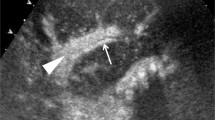Abstract
Introduction and purpose
Little use has been made so far of the intrinsic advantages of ultrasound (US) for quantifying tissue perfusion of parenchymal organs, that is, its high spatial and temporal resolution and immediate availability in any clinical situation. Since acute rejection of a kidney graft primarily involves the sub-capsular capillaries, early and detailed evaluation of blood flow in this area is highly desirable. Using a clinically established US contrast medium (USCM) of the second generation and improved US technology, we performed a study to investigate whether it is possible to adequately diagnose rejection after kidney transplant by evaluating the arterial inflow of an echo enhancer.
Patients and methods
A total of 32 patients underwent US examination with an echo enhancer (1.6 ml SonoVue, Bracco-Altana) 5 to 7 days after kidney transplantation. The examinations were performed using the Aplio US system (Toshiba) with a 3.5-MHz transducer and micro flow imaging (MI 0.1). Contrast medium inflow was determined in the renal artery and the renal cortex using Windows-based, time-intensity curve (TIC) software. The temporal difference in contrast medium inflow between the two vascular territories was determined (Dt = time baseline renal cortex—time baseline renal artery). Patients with primary graft failure (no function until day 3) were excluded (number of patients, n=2).
In patients with large peri-renal hematoma (n=6), the effect of US on perfusion was determined and the results in these cases (hematoma group) were compared with those in the remaining patients.
Results
Seventeen patients had uneventful clinical course (resistance index (RI) on day 7: 0.75±0.11). In this group US demonstrated a uniform inflow of the CM. The calculated slopes were comparable with those of the interlobar artery and renal cortex (no rejection group). Seven patients showed histologically confirmed acute rejection on days 5 to 7 after transplantation (rejection group). The RI in this group was at the upper limit on day 7 (0.77±0.08). The temporal difference in CM arrival between the two vascular territories was greater in the rejection group (2.27±0.73 s) compared with the normal group (0.97±0.62 s, p<0.05, p=significance). The difference was also increased in the hematoma group (1.5±1.3 s, p>0.05). The size of the hematoma correlated with the extent to which USCM inflow was altered. In only two cases, the USCM examination demonstrated a perfusion defect.
Conclusions
The use of echo enhancers has potential to diagnose acute kidney graft rejection in its early stages. US not only identifies kidney perfusion defects but also provides information on the effect of a large peri-renal hematoma.
Similar content being viewed by others
Author information
Authors and Affiliations
Corresponding author
Rights and permissions
About this article
Cite this article
Fischer, T., Dieckhöfer, J., Mühler, M. et al. The use of contrast-enhanced US in renal transplant: first results and potential clinical benefit. Eur Radiol Suppl 15 (Suppl 5), e109–e116 (2005). https://doi.org/10.1007/s10406-005-0173-y
Issue Date:
DOI: https://doi.org/10.1007/s10406-005-0173-y




